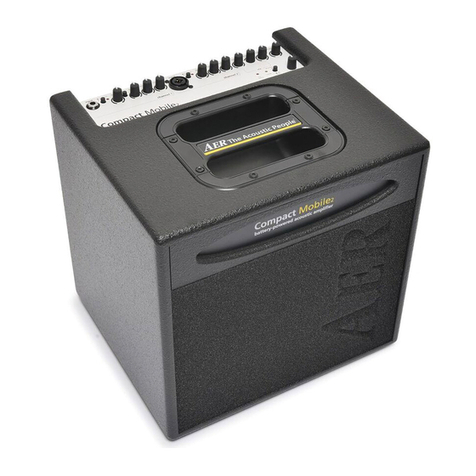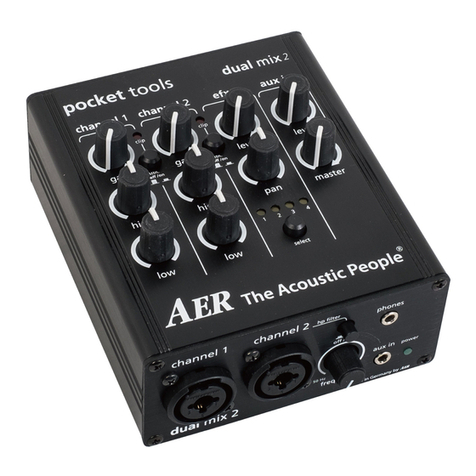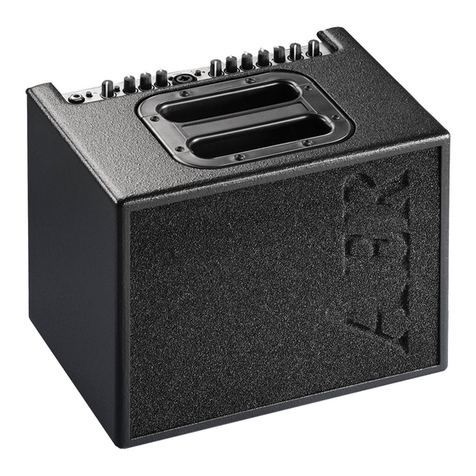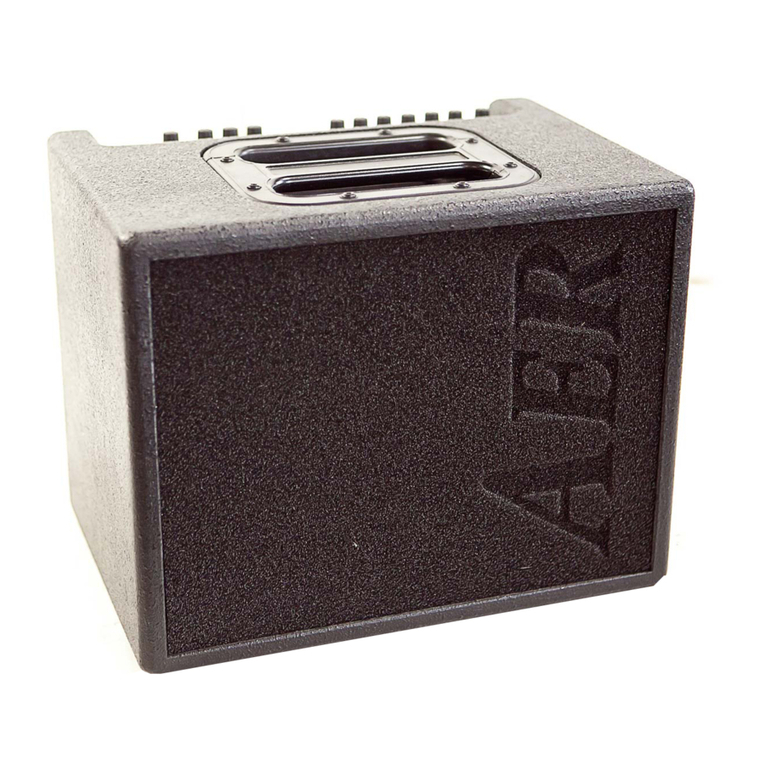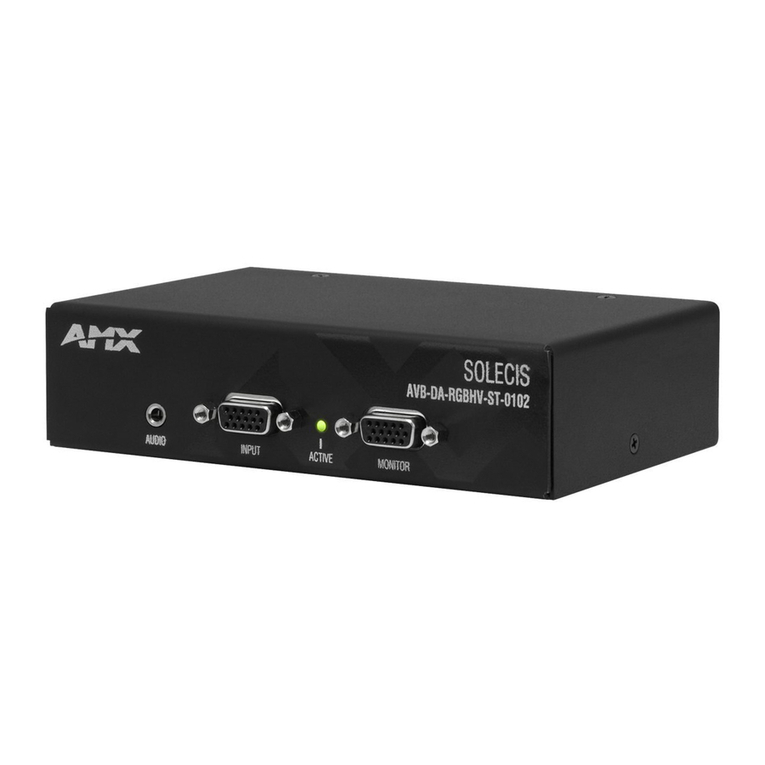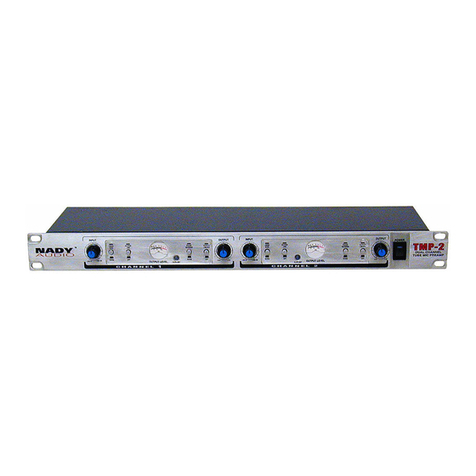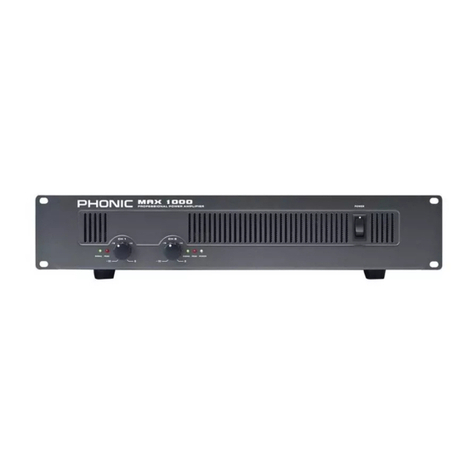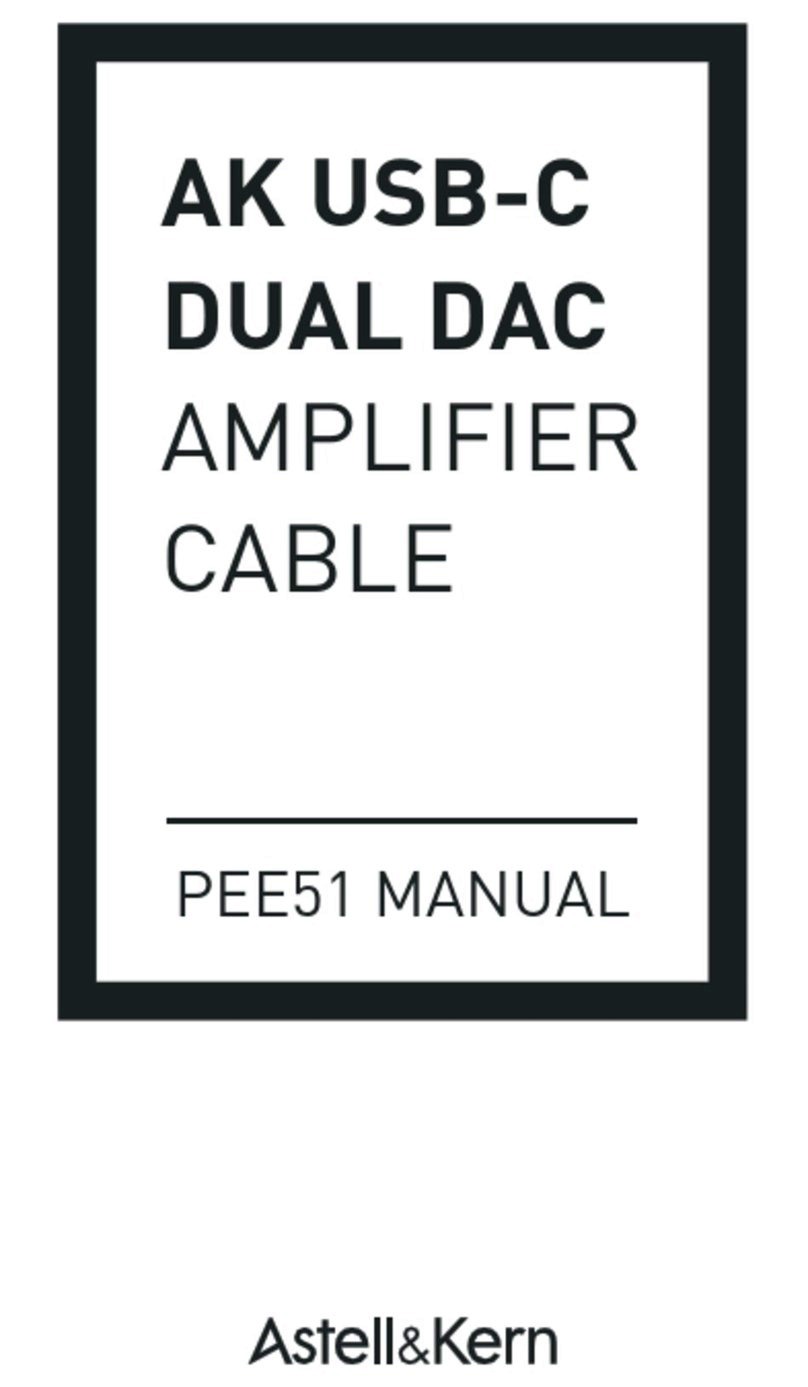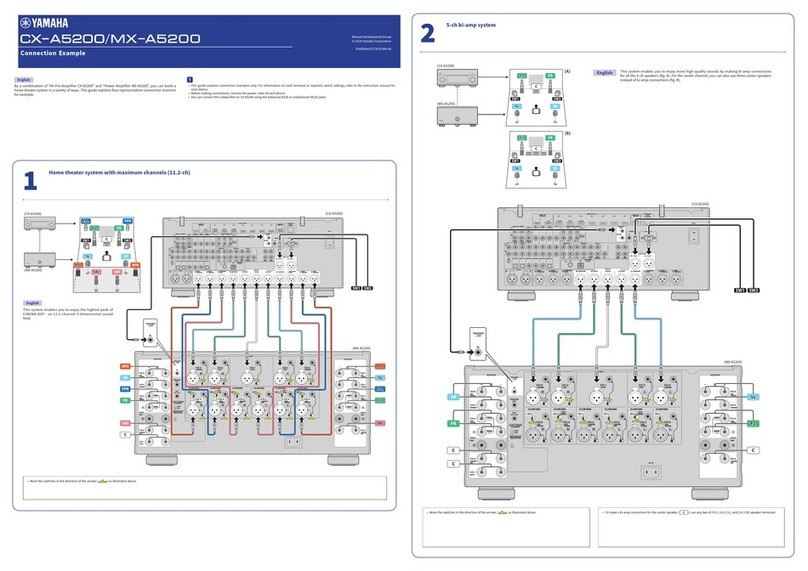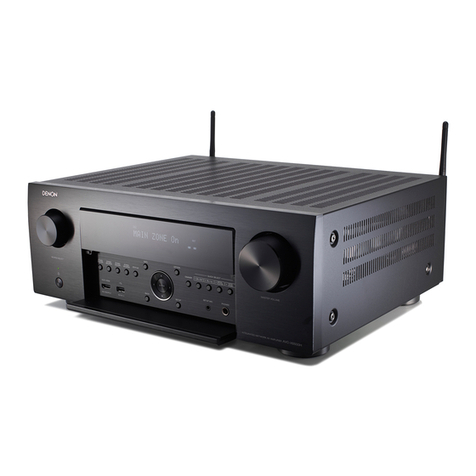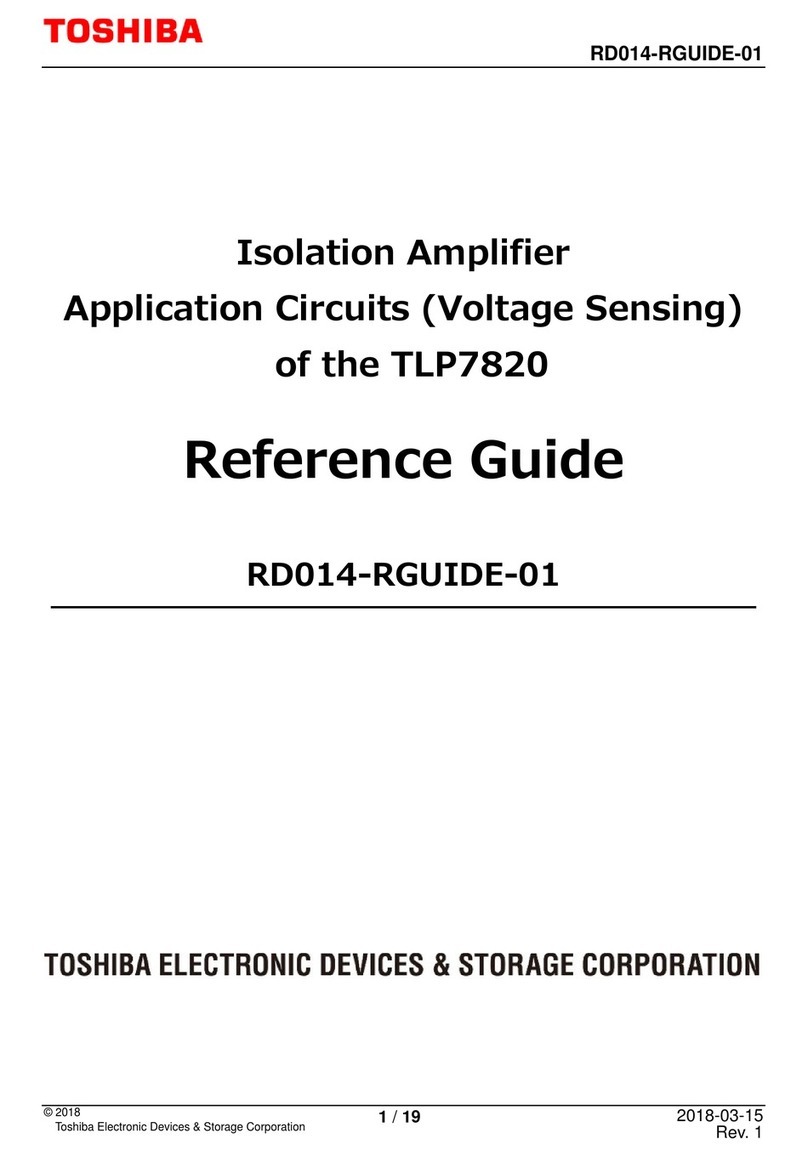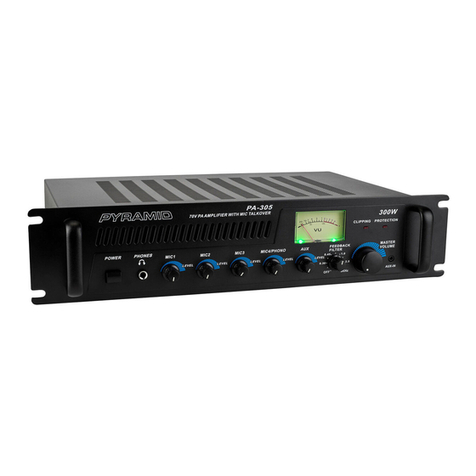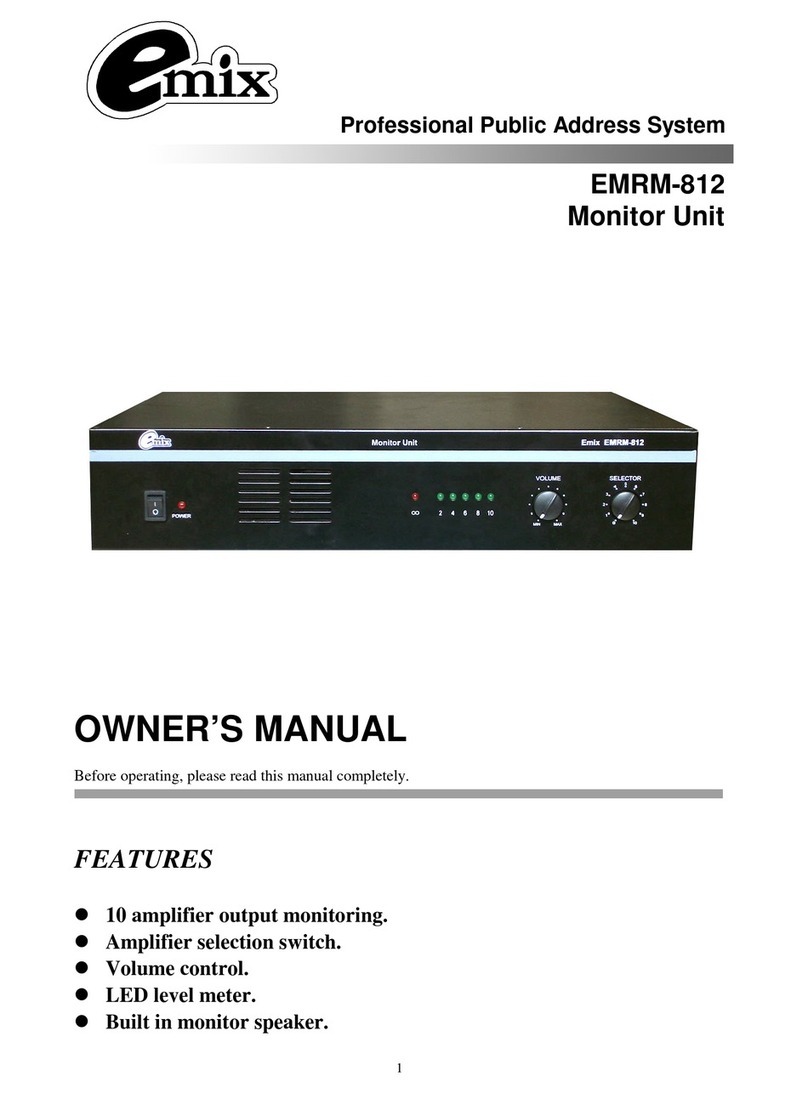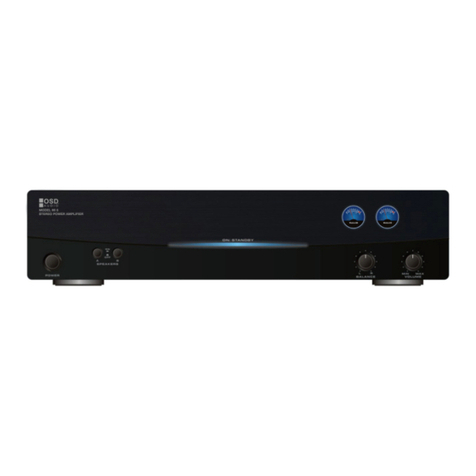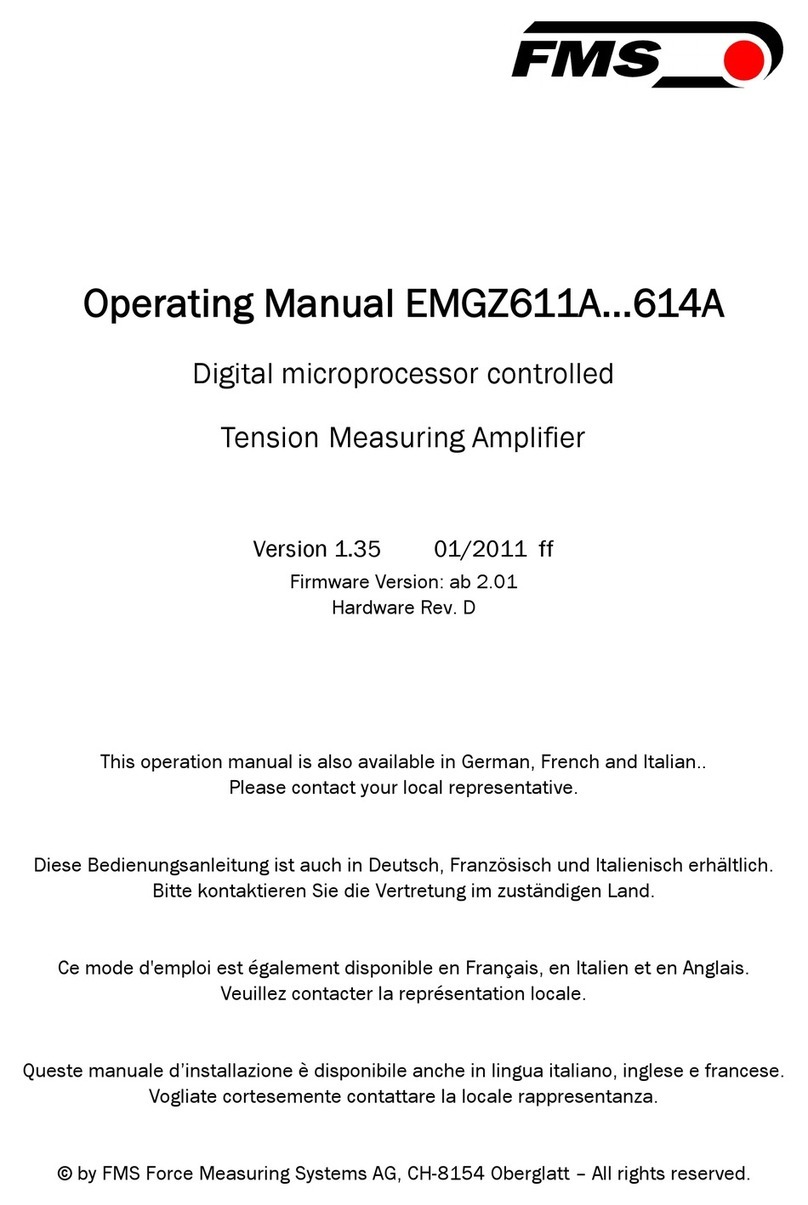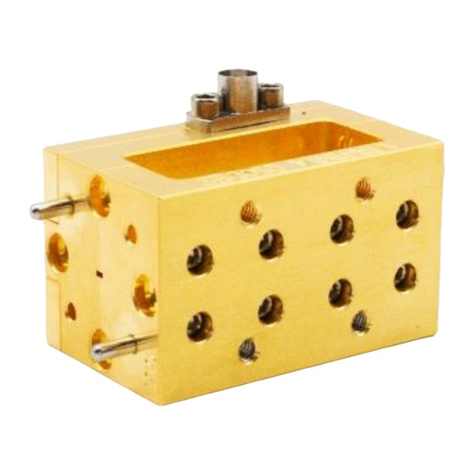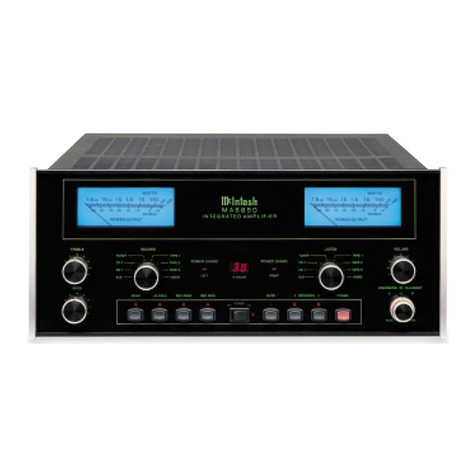AER AK15 plus User manual

1
Installation manual 11/2020
AK 15 plus

2
Checklist
Prüfen Sie den Inhalt des Systems auf
Vollständigkeit
a) 1 x AK15 plus piezo pick-up
mit 2.5 mm Klinkenstecker
b) 1 x AK15 plus Endpin Preamp mit
eingebautem Mikrofon, Soundhole
Control (SHC)
c) 1 x 9 V Batterie
d) 1 x Dual-lock™ (tape) zur Befestigung der
Batterie-Tasche
e) 1 x selbstklebendes Tape für das SHC
f) 3 x Kabelklemmen
g) Batterie-Tasche mit Klebeband
1. Einleitung
Vielen Dank, dass Sie sich für den AK15 plus
Pickup-System entschieden haben.
Wir haben unser Bestes getan, um ein Dual-Source-Ton-
abnehmersystem liefern zu können, das dem
höchsten Standard an Dynamik und natürlichem
Klang entspricht.
Der AK15 plus ist ein Zwei-Quellen-System:
Piezo-Undersaddle Tonabnehmer und einem im
Endpin-Vorverstärker integriertes Elektret-Kondensa-
tormikrofon.
Ziel war es, ein einfach zu bedienendes, vielseitiges
Tonabnehmersystem zu entwickeln, das den
wirklichen Klang des Instruments mit maximalem
Dynamikbereich erfasst.
Der AK15 plus bietet neben hoher Lautstärke und
beeindruckenden 'Punch' in Verbindung mit extrem
rauscharmen Komponenten ein optimales
Signal-Rausch-Verhältnis.
Das AK15 plus-System kann mit allen Gitarren
(Steelstring und Classic) verwendet werden.
Die Installation ähnelt allen Under-Saddle Pickup-Sys-
temen. Das Instrument ist während der Installation
keinen mechanischen Belastungen ausgesetzt.
Kein Löten erforderlich.
Viel Spaß mit Ihrem AK15 plus !

3
2. Überprüfen Sie Ihr Instrument
2.1 Allgemeine Anforderungen
• Stellen Sie sicher, dass die Brücke nicht lose
oder schräg aufgeleimt und dass die Decke
nicht eingesunken ist.
• Überprüfen Sie den Saitenabstand, Mitte
zu Mitte der Saite um sicherzustellen, dass
der Abstand mit dem AER-Tonabnehmer
übereinstimmt.
• Stellen Sie sicher, dass die Stegeinlage eine
Mindestbreite von 2,3 mm hat.
Der Piezostreifen ist 2,3 mm breit.
• Prüfen Sie den Saitendruck auf den Piezo,
indem Sie einen Winkel von 20° sicher-
stellen, je mehr umso besser. Wenn Ihr
Instrument dies nicht bietet, müssen die
Saitenschlitze (von einem Gitarrenbauer)
nachgefräst werden.
2.2 AK15 plus, SHC und Batteriehalter
• Überprüfen Sie das Innere der Gitarre, um
die ideale Position für das AK15 plus
SHC (Soundhole Control) auf der Bassseite
des Schalllochs zu ermitteln, damit Sie
ihn während des Spielens leicht bedienen
können. Die Beleistung um das Schallloch
ist von Hersteller zu Hersteller unter-
schiedlich und kann zu Konikten mit dem
SHC führen.
Einige Konstruktionen benötigen eine
Unterlage, um den SHC richtig
zu montieren. In jedem Fall aber sollte die
Klebeäche ach und frei von Staub oder
Fett sein.
• Suchen Sie die ideale Position für den
Batteriehalter.
2.3 Piezo-Einbau
• Stellen Sie sicher, dass die obere Verstre-
bung nicht mit dem Loch des Aufnahme-
kabels durch den Sattelschlitz in Konikt
steht.
• Stellen Sie sicher, dass die Schlitztiefe (ein-
schließlich PU) immer mehr als die Hälfte
der gesamten Sattelhöhe beträgt. Falls Sie
unsicher sind, fragen Sie Ihren
Gitarrenbauer.
• Stellen Sie sicher, dass der Tonabnehmer in
den Steckplatz passt und nicht wackelt.
• Überprüfen Sie die Stegeinlage. Die Mate-
rialien Knochen, Delrin® und Micarta® er-
fordern unterschiedliche Vorgehensweisen.
Nehmen Sie eine neue Stegeinlage um das
Original unberührt zu lassen.
Der Sattelschlitz muss vollständig ach und
die Stegeinlage rechteckig und ach sein.
Selbst wenn beide absolut eben sind, kön-
nen einige Anpassungen in Bezug auf die
Balance des Piezosignals erforderlich sein.
In einigen Fällen ist die Balance zwischen
den Saiten der akustischen Instrumente
nicht gleichmäßig - der Tonabnehmer
gibt dies nur wider und benötigt eine An-
passung, um den Saitendruck zu erhöhen.
Lösen Sie die Saiten und klemmen Sie sie
mit z.B. ein Kapodaster, um zu verhindern,
dass sie Sie bei dieser Aufgabe im Weg sind.
Entfernen Sie die Saiten-Pins, die
Stegeinlage und den End-Pin.
3. Holzarbeit
1. Bohren Sie ein 12-mm-Loch durch den
Endklotz der Gitarre. Verwenden Sie einen
'Reamer' und kleben Sie die Stelle mit
Masking-Tape ab um Schäden an der Gitarre
zu vermeiden. Stellen Sie sicher, dass das
Loch gerade zentriert und in einem Winkel
von 90° zum Endblock ist.
2. Bohren Sie ein 2,5-mm-Loch mit einem
Winkel von 90° durch den Steg-Schlitz.
Es ist unerheblich, auf welcher Seite geb-
ohrt wird. Vermeiden Sie es, die Beleistung
zu treen!
Für die Installation des Piezo-Tonabnehmers
sollte kein Fräsen erforderlich sein wenn der
Schlitz eine normale Länge und Tiefe hat!
Breite und Tiefe sollen ausreichend sein.
Sollte ein Fräsen erforderlich sein, lassen Sie
es von einem Gitarrenbauer ausführen.

4
Nehmen Sie den Piezo-Tonabnehmer und
führen Sie die Mini-Klinke durch das Loch
in der Gitarre. Der Piezo passt problemlos in
die meisten Stegeinlagenschlitze, der Schlitz
muss nicht 'aufgefüttert' werden. Stellen Sie
sicher, dass das Kabel keine Verdrehungen
aufweist.
Die 6 piezoelektrischen Kristalle sitzen unter
den Saiten, sie müssen nicht zentriert werden,
sondern müssen den einzelnen Kristall
berühren.
Stellen Sie sicher, dass die Stegeinlage leicht
in den Schlitz gleitet, jedoch nicht kippt.
Befestigen Sie die Stegeinlage mit Klebeband,
um den Piezo-Tonabnehmer während der In-
stallation zu schützen, und nehmen Sie einen
Streifen Klebeband, um das Piezo-
Tonabnehmerkabel in der Gitarre als
temporäre Zugentlastung an einer oberen
Leiste zu befestigen.
Die Stegeinlage sitzt höher, nachdem der
Piezostreifen installiert ist. Für eine optimale
Saitenlage müssen Sie von der Stegeinlage
etwas Material abschleifen.
Befestigen Sie das Schleifpapier mit doppel-
seitigem Klebeband auf einer völlig ebenen
Oberäche und schleifen Sie ausreichend
Material von der Unterseite des Sattels ab.
Überprüfen Sie immer, ob der Sattelboden
ach bleibt!
4. Endpin-Preamp-Montage
Nach dem Bohren des 12 mm Lochs im
Gitarren-Endblock, schieben Sie denPre-
amp-Endpin durch das Loch und wählen Sie
die richtige Position mit der Sechskant-Ge-
genmutter in der Gitarre.
Befestigen Sie dann den EndPin schließlich
mit der zweiten Sechskantmutter von außen
und stecken Sie einen Inbusschlüssel durch
das Loch im Gewinde, um ihn als Verriegelung
gegen Verdrehen zu verwenden. Wenn der
Endstift sicher befestigt ist, schrauben Sie den
Gurtknopf an.
Stecken Sie nun den Piezo-Tonabnehmer in
die Piezo-Buchse des EndPin-PreAmps. Es
sollte ein deutliches„Klicken“ zu hören sein,
um sicherzustellen, dass er richtig sitzt. Das
interne Mikrofon ist am besten auf den Boden
der Gitarre gerichtet.
Experimentieren kann jedoch zu anderen
Ergebnissen mit Ihrem spezischen Instru-
ment führen.
5. Testlauf
Führen Sie vor dem Befestigen der
Batterietasche einen Testlauf durch.
Verbinden Sie die Batterie-Pole mit dem
Stecker des AK15 plus-Systems.
Verbinden Sie nun das SoundHole
Control (SHC) mit dem kleinen Stecker.
Sie können jetzt die Klinkenbuchse an einen
Verstärker anschließen. Durch Einstecken der
Klinke in die EndPin-Buchse wird der Strom-
kreis geschlossen und das AK15 plus System
eingeschaltet.
Selbst wenn Sie nicht spielen, verliert das
System Batterieleistung bei eingestecktem
Klinkenstecker.
Ohne eingesteckten Klinkenstecker wird kein
Batteriestrom verbraucht.
Hinweis:
Wenn Sie ein Stereo-Kabel verwenden
und Ihr Verstärker z. B.: AER Compact 60_4
9-V-Phantomspannung bereitstellt,
können Sie auf die interne Batterie verzichten.
Die Werkseinstellung des internen Mikrofon ist für
die überwiegende Mehrheit der Gitarristen geeig-
net, sodass in den meisten Fällen keine Korrektur
erforderlich ist.
Werkseinstellungen:
Piezo: + 10 dB
Mikrofon: + 10 dB
Überprüfen Sie zuerst den Klang des Piezo-Tonab-
nehmers und hören Sie, ob alle Saiten gleich laut
klingen.
Fügen Sie nun das Mikrofonsignal hinzu, indem
Sie den Mikrofonregler am Soundhole Control
drehen. Wenn Sie auf die Decke des Instruments
klopfen, können Sie das Mikrofonsignal sehr
leicht hören. Alles in Ordnung?
Fahren Sie mit dem nächsten Schritt fort.

5
5. Installation der Batterie
Der Batterietasche hat auf der Rückseite einen
Klettverschluss.
Ziehen Sie die Schutzfolie vom
Dual-Lock™ Klebeband ab und kleben Sie es auf
den Halsblock oder den oberen Teil im Inneren
der Gitarre. Stellen Sie sicher, dass die Klebeäche
ach und sauber ist. Viele Tonhölzer enthalten
natürliche Öle, die Klebeäche muss dann vor
dem Kleben des Dual Lock™ fettfrei gemacht
werden. Befestigen Sie dann die Batterie-Tasche
fest mit dem Dual-Lock™ Klebeband. Verbinden
Sie die Batteriekontakte des EndPin-PreAmps mit
einer frischen Batterie und stecken Sie sie diese in
die Batterie-Tasche.
Beachten Sie bitte:
Sie haben verschiedene Möglichkeiten bezüglich
der Position der Batterie-Tasche. Jede davon kann
ein Kompromiss sein, aber das Ziel muss sein, ein-
en leichten Zugang mit einer festen Position von
Batterie und Batterie-Tasche zu kombinieren.
Hinweis:
Das AK15 plus-System ist nicht für
'Microphone-only' ausgelegt!
Das Mikrofon sorgt für mehr Denition und
Authentizität sowie für ein akustisches Ambiente,
das den Klang weiter, perkussiver, natürlicher
macht. Zu viel Mikrofonsignal macht den Ton
jedoch„hohl“ und kann zu Rückkopplungen
führen. Der Piezo bei voller Lautstärke kann die
Verwendung des Mikrofons unwirksam erschein-
en lassen.
Wenn Sie beide Signale laut und deutlich
hören können, können Sie das Kabel mit den
beigelegten Kabelklemmen befestigen.
7. Schalllochkontrolle und Endmontage
Abhängig von der Konstruktion der Gitarre kann
es erforderlich sein, unterschiedliche Materialien
zu verwenden, um die Schalllochsteuerung zu
unterlegen oder aufzufüllen. Setzen Sie zuerst
das Soundhole Control ein, um die Position zu
bestimmen.
Wenn Sie das beiliegende Klebepad verwenden,
müssen beide Oberächen fettfrei sein.
Positionieren Sie das Soundhole Control (SHC) so,
dass Sie es leicht erreichen können und befesti-
gen Sie das Kabel an einer sicheren Position.
Wenn sich die Gitarre in der Spielposition bend-
et, ist das rechte Poti (in Richtung Steg) der Piezo-
Lautstärke-Regler, das linke Poti (in Richtung des
Halses) mischt das Mikrofonsignal hinzu.
Jetzt, nach der Positionionierung können Sie
die Kabel mit den beigefügten Kabelklemmen
befestigen um unerwünschte Raschelgeräusche
zu vermeiden.
Besaiten und stimmen Sie Ihr Instrument.
8. Betrieb
Das AK15 plus ist ein sehr leistungsfähiges
System, das ein starkes Piezosignal mit einem
zusätzlichen Mikrofonsignal kombiniert. Es wurde
entwickelt, um das Mikrofon für Obertöne und
mehr Lebendigkeit mit dem Tonabnehmer zu
mischen.
Das Mikrofon funktioniert nicht alleine
Abhängig von Ihren persönlichen Klangvor-
lieben können Sie die gesamte Bandbreite der
SHC-Mikrofonsteuerung nahezu maximal nutzen.
Der Lautstärkeregler passt Ihr Gesamtausgangs-
signal an. Beginnen Sie in der Nullposition (kein
Ausgangssignal, ganz nach links) und drehen Sie
es im Uhrzeigersinn, um den Ausgangspegel zu
erhöhen.
Beachten Sie jedoch Folgendes:
Der optimale Bereich dieser Steuerung liegt
zwischen 30 und 60% Drehung!
Volle Lautstärke ist weder notwendig noch emp-
fohlen. Durch Hinzufügen der Mikrofonlautstärke
wird ein natürlicherer und lebendigerer Klang
erzielt. Zu viel Mikrofonsignal kann zu Rückkop-
plungen führen. Verringern Sie in diesem Fall die
Mikrofonlautstärke.
Durch Einstecken des Klinkensteckers in die
Endpin-Buchse wird der Stromkreis geschlossen
und das System eingeschaltet. Ohne Klinken-
stecker ist das System ausgeschaltet und es gibt
keinen aktiven Batterieverbrauch, nur die übliche
Selbstentladung nicht verwendeter Batterien.

6
9. Fehlerbehebung
Kein Piezo Signal
Stellen Sie sicher, dass Sie den Klinkenstecker
richtig eingesteckt haben. Es sollte ein deutliches
„Klicken“ zu hören sein, wenn der Kugelklinken-
stecker sicher in der Buchse sitzt.
Kein Mikrofonsignal
Zu viel oder zu wenig Mikrofonsignal
Der Mikrofon-Master-Pegel wird mit dem
Schalllochregler (Master-Lautstärke + zusätzlicher
Mikrofonpegel) gesteuert.
Wenn Sie Probleme haben, den richtigen
Mikrofon-Anteil einzustelnen, oder wenn Sie der
Meinung sind, dass zu viel oder nicht annähernd
genug Mikrofonsignal vorhanden ist, haben wir
folgende Lösung:
Im Vorverstärker bendet sich ein kleines Poten-
tiometer, mit dem Sie das Mastervolumen für das
Mikrofonsignal erhöhen oder verringern können.
Dies ist eine sehr empndliche Einstellung, daher
die Platzierung innerhalb des Vorverstärkers, und
mit einem kleinen Aufkleber abgedeckt.
Bitte verwenden Sie dieses sehr sensibel. Wenn
Sie zuviel Mikrofonsignal haben, sodass Sie den
Schalllochregler nicht verwenden können, um
die richtige Menge im Mix zu erhalten, oder wenn
der Schalllochregler vollständig geönet ist und
Sie immer noch mehr Mikrofonsignal verwenden
können, ist der Zeitpunkt, um den internen Regler
zu verwenden.
Kein Ausgangssignal
Stellen Sie sicher, dass die Batterie
ausreichend aufgeladen ist, um das System zu
betreiben. Die Anzeige LED am Soundhole Control
leuchtet, wenn die Batterie schwach ist.
Stellen Sie sicher, dass der Gurthalter am Endpind
fest angeschraubt ist. Gurtbewegungen lösen
manchmal die Endpinschraube, was zu einem
Kontaktfehler führen kann.
Es gibt Aftermarket-Lösungen mit Straplocks für
Akustikgitarren, die dies verhindern können.
Ungleichmäßige Balance
Die Beachtung der optimalen Saitenbalance ist ein
übliches Problem bei allen Tonabnehmersystemen
abhängig von der Balance der Saiten am Instru-
ment selber und vom Druck auf dem Piezo.
Hören Sie, wie Ihr Instrument ohne PU klingt.
Spielen Sie jede Saite einzeln mit dem gleichen
Anschlag.
Möglicherweise stellen Sie fest, dass die natürliche
Wiedergabe der Saiten bereits ungleichmäßig ist.
Zusammenfassung
Wir haben das AK15 plus system so konzip-
iert, dass es einen klaren und dynamischen
Ton erzeugt. Diese hohe dynamische Leistung
bedeutet, dass ihre Batterielaufzeit geringer ist
als bei anderen Systemen. Halten Sie stets eine
Ersatzbatterie gribereit.
Das AK15 plus-System kann ohne Batterien
verwendet werden, wenn die 9-Volt-Phan-
tospannung des AER Compact 60/4- oder
Domino 3-Verstärkers verwendet wird. Die
meisten unserer anderen Verstärker können
leicht modiziert werden, um eine 9-Volt-Phan-
tomspannung am Buchseneingang bereitzus-
tellen. Überprüfen Sie dazu das Handbuch Ihres
Verstärkers.
Für die Phantomspannung ist eine
Standard-Stereo-Kabelverbindung erforderlich.
Guter Klang ist eine Inspiration für das Leben.
Wir hoen, dass wir mit dem AK15 plus dazu
beitragen können.

7
Checklist
Check the contents of the package to make
sure everything is complete:
a) 1 x AK15 plus piezo pick-up
with 2.5 mm jack
b) 1 x AK15 plus endpin preamp with
integrated microphone, soundhole
control (SHC)
c) 1 x 9V battery
d) 1 x Dual-lock™ (tape) for battery pouch
e) 1 x adhesive tape for SHC
f) 3 x Cable clamps
g) battery pouch with tape
1. Introduction
Thank you for choosing the AK15 plus pickup
system.
We have done our outmost best to be able to
deliver a dual source pickup system that matches
the highest standard of dynamics and natural
sound.
We hope that you will enjoy the AK15 plus.
The AK15 plus is a two source system, the under-
saddle piezo crystal pickup is combined with an
electret condenser microphone integrated in the
endpin pre-amp.
It has been a developing goal to come up with an
easy to use, versatile pickup system that captures
the true sound of the instrument with a maxi-
mum of dynamic range – even if it exceeds the
dynamic range of the instrument.
The AK15 plus provides high volumes and
impressive punch combined with low noise com-
ponents for best possible signal to noise ratio.
The AK15 plus system can be used with all gui-
tars (steelstring and classic) which allow under
saddle pickup installation with string spacings
from 10 to 12.5 mm.
The installation is similar to all under-saddle
pickup systems. The instrument does not suer
mechanical stress in use or during installation.
There is no soldering necessary.
Read on and have fun using your AK15 plus!

8
2. Check and inspect the guitar
2.1 General Requirements
• Make sure that the bridge is not lifting or
tilted and that the top is not sunken in.
• Check the string spacing, centre to centre of
the string, or middle between a pair, to make
sure it matches the AER pickup.
• Make sure that the saddle has a minimum
width of 2,3 mm. The undersaddle pickup is 2,3
mm wide.
• Check the string pressure on the pickup crystal
by assuring a minimum 20° break angle, if
more all the better. If your instrument does not
provide this, the string slots will need ramping
(done by a luthier).
2.2 Regarding the AK15 plus,
SHC and battery holder
• Check the inside of the guitar to identify
the ideal position for the AK15 plus SHC
(soundhole control) on the bass side of the
soundhole for easy operation while perform-
ing. Bracing around the soundhole diers
between makers and can conict with the
control unit. Some guitar constructions re-
quire an underlay to glue the SHC on properly.
In any case should the gluing surface be at
and free of dust or grease.
• Identify the ideal position for the battery
holder according to Battery Holder
Installation
2.3 Regarding the Pickup
• Check that the top bracing does not conict
with the projected pickup cable hole through
the saddle slot.
• Verify that the slot depth (including pickup)
always remains more than half of the total
saddle height. Not enough space for the sad-
dle can cause bridge cracks. Check with your
qualied luthier.
• Make sure that the pickup ts the slot and
does not tilt within.
• Check the saddle. The materials, bone, Delrin®
and Micarta® require dierent attention. You
may consider getting a replacement saddle to
work on, keeping the original untouched.
The saddle-slot needs to be completely at
and the saddle rectangular and at. Even
if both are at, some adjustments towards
pickup signal balance may be necessary. In
many cases the balance between the strings
of the acoustic instruments is not even – the
pickup just reects this and needs compen-
sation to increase the string-pressure. Loosen
the strings and clamp them with e.g. a capo
to prevent them hindering you at your task.
Remove the string-pins, the saddle and the
endpin. Depending on what work needs to
be done, use paper masking tape to protect
the surface of your instruments around
bridge and endpin. Always check the tape for
possible residue on your guitar rst at a‘safe’
spot ... you never know!
3. Woodwork
1. Drill or ream a 12 mm hole to t the endpin
pre-amp. Make sure that it is centred prop-
erly and in a 90° angle to the end block.
2. Drill a 2.5 mm hole (for a wider slot use a
wider drill) with a 90° angle through the
saddle slot and the top of the guitar at the
edge of the slot. It is immaterial which side
is drilled, bass or treble side. Avoid hitting
the braces!
For installing the piezo pickup there should
be no routing required if the slot has a regular
length and depth! The width and depth should
be sucient. Should your guitar require rout-
ing, have it done by a qualied luthier.
Take the piezo pickup and lead the mini-jack
through the hole in the top of the guitar. The
piezo will t most saddle slots easily, the slot
will not require lling. Make sure that there are
no twists in the cable.
The 6 piezoelectric crystals sit underneath the
strings, they don‘t have to be centred, but do
need to touch the individual crystal. You can
use the cable as a spring to keep the pickup in
place.
Make sure the saddle slides easily into the slot,
however it should not tilt. Fixate the saddle
with masking tape to protect the piezo pickup

9
during installation, and use a strip of masking
tape to stick the piezo pickup cable inside the
guitar to a near top brace, as strain relief.
The saddle will sit higher now that the piezo is
installed. For proper playing action, remove some
material from the saddle. Use double side tape to
xate sanding paper to a
completely at surface and sand o enough
material from the bottom of the saddle to match
your playing requirement. Always check that the
bottom of the saddle stays at!
4. Endpin Mounting
After drilling the 12 m hole in the guitars end
block, start from inside the guitar, slip the pre-
amps endpin through the endpin hole and prese-
lect the correct position with the hex counter nut
inside the guitar.
Then x the endpin nally with the second
hex nut from the outside, pushing an allen key
through the hole in the thread for use as lock
against twisting. When the endpin is safely xed,
screw on the strap-button.
Now plug the piezo pickup connector into the
piezo socket of the endpin, there should be an au-
dible„click“, to make sure it sits rmly. The internal
microphone is best pointed towards the back
of the guitar. Experimentation may yield better
results with your specic instrument though.
5. Test Run
Before xing the battery pouch, it is best to do a
test run. Connect the battery pins to the connec-
tor of the AK15 plus system.
Now connect the soundhole control unit with the
small connector.
You can then connect the output jack to an am-
plier. Plugging the jack into the endpin socket
closes the circuit and switches on the AK15 plus
system, without jack there is no battery power
consumption. Even when not playing, the system
will lose battery power when a jack plug is con-
nected. Only plug in when you want to use the
pickup system.
The factory setting of the internal microphone
trim pot will be suitable for the vast majority of
guitars, so in most cases, there is no correction
necessary.
Factory settings:
Piezo: +10dB
Microphone: +10dB
Check the sound of the piezo pickup rst and
listen if all strings sound equally loud. Imbalance
in string volumes should be addressed by a
luthier, or follow the tips in the trouble shooting
section. Now add microphone signal by turning
the Mic control. Tapping the top will let you hear
the microphone signal very easily. Sounds good?
Go to the next step.
5. Battery Pouch Installation
The battery pouch has a Velcro strip on the
backside.
Peel the masking tape o the Dual-lock™ (tape)
and glue it to the neck block or the upper bout of
the guitar. Make sure the gluing surface is at and
clean. Many tone woods contain natural oils, and
the gluing surface needs to be made grease free
before gluing the Dual Lock™. Then attach rmly
the battery bag to the Dual-lock™. Connect the
battery contacts from the endpin preamp with a
fresh battery and put it in the pouch.
Please consider:
You have several options regarding the position
of the battery pouch, each of them may be a
compromise, but the aim must be to combine
easy access with a rm position of battery and
battery-pouch. The cross braces of the upper
bout inside the guitar may be used as additional
support against gravitational force.
Whatever position you choose: You will have to
loosen or even remove the strings, when a battery
change is necessary.
Note:
The AK15 plus system is not made for‚micro-
phone-only‘ performance! You will nd a surpris-
ingly warm yet strong and clear tone from the
piezo due to a suitable electronic environment.
The microphone will add denition, and authen-
ticity as well as an acoustic ambience, which
makes the sound more natural. Too much micro-
phone signal however will make the tone‚hollow‘
and can cause feedback. The piezo at full volume
may make microphone use impractical. All this
has been experienced without using a feedback

10
buster. If you can hear both signals loud and clear
you can x the cable with the cable clamps.
7. Soundhole Control and Final Assembly
Depending upon the construction of the guitar,
you may nd it necessary to use dierent materi-
als to underlay or pad the soundhole control. First
dry-t the control unit to determine the position.
If adhesive tape is used, make sure to degrease
both surfaces. Position the SHC where you can
reach it easily and x the cable in a safe position.
With the guitar in playing position, the right pot
(in the direction of the bridge) should be the
master volume, the left pot (in the direction of the
neck) adds the microphone signal.
Now, after degreasing the position of the
cable clamps, x these to the side of the
guitar and secure the cables to avoid unwanted
rattling noises. String up your guitar and bring the
instrument up to pitch.
That should be it!
8. Operation
The AK15 plus is a very powerful system, which
combines a strong piezo signal with an additional
microphone signal. It is designed to blend the
microphone to the pickup for overtones and
more liveliness.
The mic does not work alone!
You can make use of the whole range of the SHC
microphone control to almost maximum, de-
pending on your personal sound preferences.
The volume control adjusts your overall output
signal. Starting in zero position (no output signal,
over to far left), turn it clockwise to boost the out-
put level, but please regard: the optimal range of
this control is between 30 and 60% rotation! Full
volume is neither necessary nor recommended.
Adding the microphone volume will yield a more
natural and lively sound. Too much microphone
signal can cause feedback, lower the microphone
volume if this occurs.
Plugging the jack into the endpin-socket closes
the circuit and switches the system on. Without
jackplug the system is switched o and there is no
active battery consumption, just the usual self-dis-
charge of unused batteries.
10. Troubleshooting
No piezo signal
Make sure you have connected the jack connector
properly. There should be an audible„click“ when
the ball-ended jack safely sits in the 2.5 mm plug.
It may take a little eort.
No mic signal
Too much or too little mic signal
The microphone master level is pre-adjustable
independently at the preamp and controlled with
the soundhole control (master volume+ added
microphone level). If you have trouble dialing in
the right amount of microphone signal, if you
feel there is too much microphone signal, or not
nearly enough, we have a solution for that. Inside
the preamp we have a small potentiometer with
which you can increase or decrease the master-
volume for the mic signal. This is a very delicate
invasion, hence the placement inside the pre-
amp, please use this very carefully. If you have so
much mic signal that you can’t use the soundhole
control to get the right amount in the mix, or if the
soundhole control is fully open and you still could
use more mic signal is the only time to use this
internal control.
No output signal
Ensure that the battery still has enough charge
to operate the system. The indicator light on the
soundhole control unit will light if the battery has
low power. If the battery has no power at all, this
light will eventually dim.
Ensure that the strap holder on the endpin is
screwed on tightly. Strap movements some-
times loosen the strap holder which may lead
to a contact fault in the endpin socket. There
are aftermarket solutions with straplocks for
acoustic guitars that may prevent this.
Uneven balance
Attention to proper string balance is a normal
issue with all pickup systems – more or less
obvious – depending e.g. on the dynamic range
of the systems.
Just listen to your instrument as it is without
pickup and play each individual string one after
the other with the same impulse. You may nd
that the natural reproduction of the strings
is already uneven. Just one example of many
reasons for uneven reproduction.

11
How to react:
If you don’t have a luthier at hand, go through
the following steps.
Assuming the installation of the saddle is
correct, all surfaces even and straight and the
pickup is working properly, you can add layers
of scotch tape to the saddle at weak positions
to increase the pressure on relevant crystals.
Sounds simple, but needs a little experience as
all piezos are connected and a change of one
factor may have eect on others too. To nd
the proper balance may require a little extra
time and work which is annoying for everyone
– especially the installer – but it has to be done
– no way around it!
In general
We have designed the AK15 plus system to
produce the clearest and most dynamic sound
possible. This high dynamic output means that
your battery life will be less long than with oth-
er mainstream systems. The rewards however
outweigh the use of an extra battery.
The AK15 plus system can be used without any
batteries when using the 9 Volt phantom power
of the AER Compact 60/4 or Domino 3 ampli-
er. Most of our other ampliers can be easily
modied to provide 9 Volt phantom power
on the jack input. Check your manual for this.
Phantom power needs a standard stereo jack
cable connection. Our high output volume is
suited for all amplication systems.
Good sound is an inspiration for life.
We hope we can contribute to this with the
AK15 plus.

Sales
Africa, America, Asia, Oceania
aer music gmbh
Haberstrasse 46
D-42551 Velbert
info@aer-music.de
aer amplier gmbh
Haberstrasse 46
D-42551 Velbert
info@aer-amplier.de
Sales
Europe
www.aer-music.de
Other manuals for AK15 plus
1
Table of contents
Languages:
Other AER Amplifier manuals

AER
AER The Acoustic People Compact 604 User manual
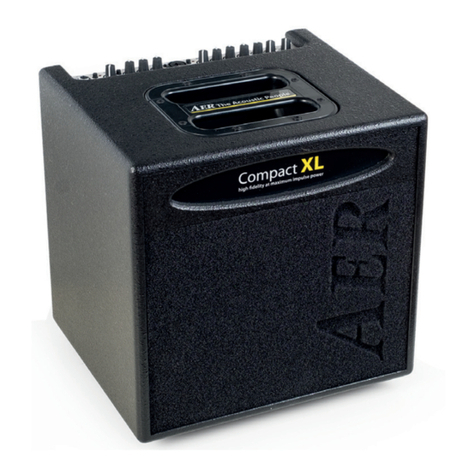
AER
AER Compact XL User manual
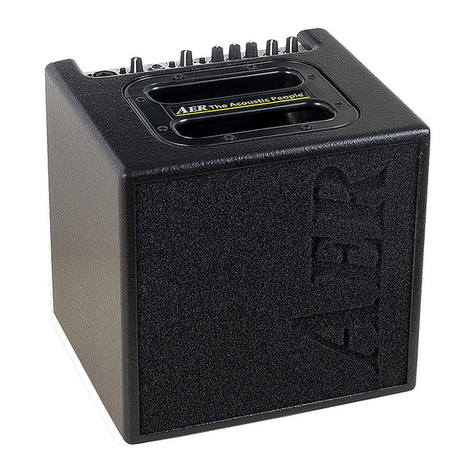
AER
AER Alpha User manual
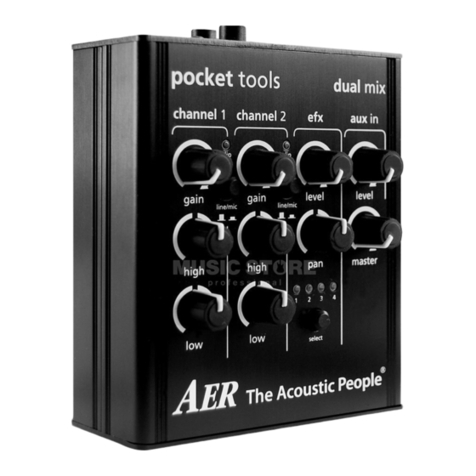
AER
AER pocket tools dual mix User manual
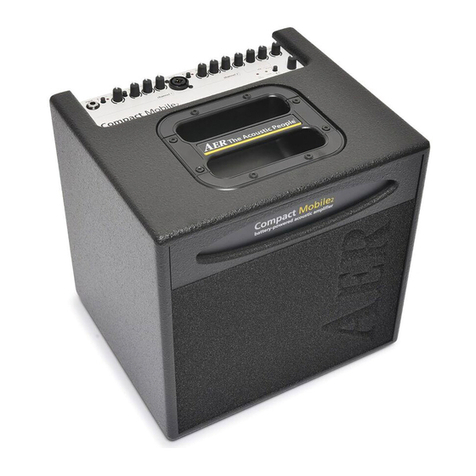
AER
AER Compact Mobile2 User manual
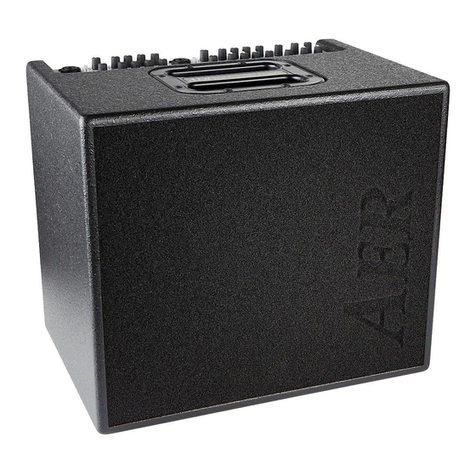
AER
AER domino 3 User manual

AER
AER The Acoustic People pocket tools colourizer User manual
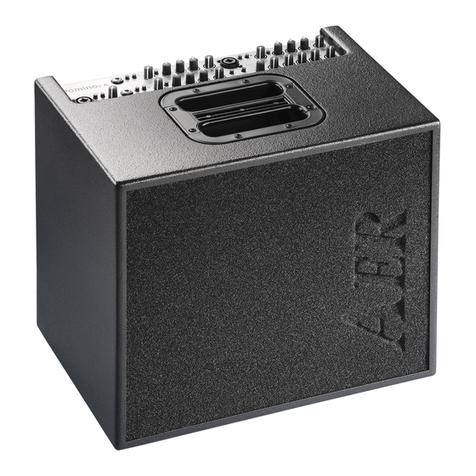
AER
AER Domino 2A User manual
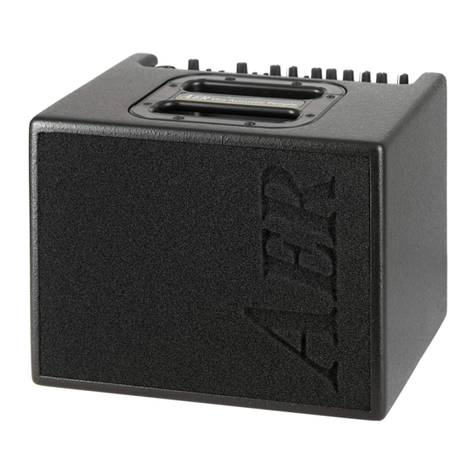
AER
AER Compact Classic pro User manual

AER
AER Bottom Line Amp Two User manual



